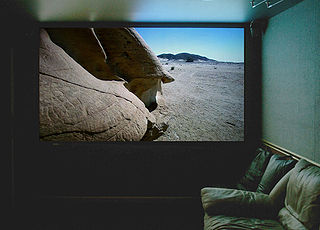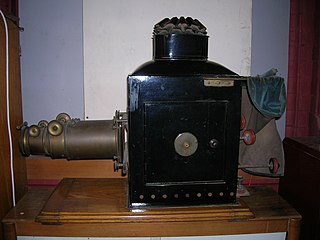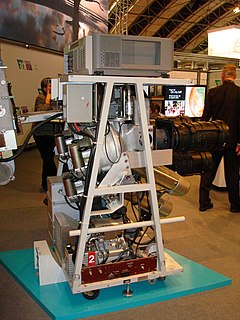
The magic lantern, also known by its Latin name lanterna magica, is an early type of image projector employing pictures painted, printed or produced photographically on transparent plates, one or more lenses, and a light source. It was mostly developed in the 17th century and commonly used for entertainment purposes. It was increasingly applied to educational purposes during the 19th century. Since the late 19th century smaller versions were also mass-produced as a toy for children. The magic lantern was in wide use from the 18th century until the mid-20th century, when it was superseded by a compact version that could hold many 35 mm photographic slides: the slide projector.

A slide projector is an opto-mechanical device for showing photographic slides.

An overhead projector (OHP) is a variant of slide projector that is used to display images to an audience..

An LCD projector is a type of video projector for displaying video, images or computer data on a screen or other flat surface. It is a modern equivalent of the slide projector or overhead projector. To display images, LCD projectors typically send light from a metal-halide lamp through a prism or series of dichroic filters that separates light to three polysilicon panels – one each for the red, green and blue components of the video signal. As polarized light passes through the panels, individual pixels can be opened to allow light to pass or closed to block the light. The combination of open and closed pixels can produce a wide range of colors and shades in the projected image.

A video projector is an image projector that receives a video signal and projects the corresponding image on a projection screen using a lens system. All video projectors use a very bright light or laser to project the image, and most modern ones can correct any curves, blurriness, and other inconsistencies through manual settings.

Digital Light Processing (DLP) is a set of chipsets based on optical micro-electro-mechanical technology that uses a digital micromirror device. It was originally developed in 1987 by Larry Hornbeck of Texas Instruments. While the DLP imaging device was invented by Texas Instruments, the first DLP-based projector was introduced by Digital Projection Ltd in 1997. Digital Projection and Texas Instruments were both awarded Emmy Awards in 1998 for the DLP projector technology. DLP is used in a variety of display applications from traditional static displays to interactive displays and also non-traditional embedded applications including medical, security, and industrial uses.
A projector is a device that projects an image on a surface.

A movie projector is an opto-mechanical device for displaying motion picture film by projecting it onto a screen. Most of the optical and mechanical elements, except for the illumination and sound devices, are present in movie cameras.

The opaque projector, epidioscope, epidiascope or episcope is a device which displays opaque materials by shining a bright lamp onto the object from above. A system of mirrors, prisms and/or imaging lenses is used to focus an image of the material onto a viewing screen. Because they must project the reflected light, opaque projectors require brighter bulbs and larger lenses than overhead projectors. Care must be taken that the materials are not damaged by the heat generated by the light source. Opaque projectors are not as common as the overhead projector.

A slide show is a presentation of a series of still images on a projection screen or electronic display device, typically in a prearranged sequence. The changes may be automatic and at regular intervals or they may be manually controlled by a presenter or the viewer. Slide shows originally consisted of a series of individual photographic slides projected onto a screen with a slide projector. When referring to the video or computer-based visual equivalent, in which the slides are not individual physical objects, the term is often written as one word, slideshow.

An Eidophor was a television projector used to create theater-sized images from an analog video signal. The name Eidophor is derived from the Greek word-roots ‘eido’ and ‘phor’ meaning 'image' and 'bearer' (carrier). Its basic technology was the use of electrostatic charges to deform an oil surface.
Rear projection is part of many in-camera effects cinematic techniques in film production for combining foreground performances with pre-filmed backgrounds. It was widely used for many years in driving scenes, or to show other forms of "distant" background motion.
Precursors of film are often referred to as precinema, or 'pre-cinema'. Terms like these are disliked by several historians, partly because they seem to devalue the individual qualities of these media by presenting them as a small step in the development of a later invention. For instance: the flip book, zoetrope and phenakistiscope are very tactile devices that allow study and play by manipulating the motion by hand, while the projected image in cinema is untangible. It should also be noted that such devices as the zoetrope were not replaced by cinema: they were still used after the breakthrough of film. Furthermore, many early media examples are also part of a tradition that not only shaped cinema, but also home video, video games, computer-generated imagery, virtual reality and much more. The study of early media devices is also part of a wider and less teleological approach called media archaeology.
The ultra-high-performance lamp, a high-pressure mercury arc lamp often known by the Philips trademark UHP, was originally known as the ultra-high-pressure lamp, because the internal pressure was as much as 200 atmospheres. It was developed by Philips in 1995 for use in commercial projection systems, home theatre projectors, MD-PTVs and video walls. Unlike other common mercury vapor lamps used in projection systems, it is not a metal halide lamp, but uses only mercury. Philips claims a lifetime of over 10,000 hours for the lamps. These lamps are highly efficient compared to other projection lamps – a single 132 watt UHP lamp is used by DLP manufacturers such as Samsung and RCA to power their DLP rear-projection TV lines.

Rear-projection television (RPTV) is a type of large-screen television display technology. Until approximately 2006, most of the relatively affordable consumer large screen TVs up to 100 in (250 cm) used rear-projection technology. A variation is a video projector, using similar technology, which projects onto a screen.
Bryan-Gooding Planetarium in the Alexander Brest Science Theatre is a planetarium in the Museum of Science and History in Jacksonville, Florida, U.S. It was built in 1988 and featured a 60-foot-diameter (18 m) dome-shaped projection screen, JBL stereo sound system, and a Zeiss Jena Optical mechanical planetarium star projector. The facility has seating for 200, and approximately 60,000 people see a planetarium show each year.
A large-format slide projector is a kind of slide projector for large image projection which has a very powerful light source. Therefore, it is necessary to use a large slide format to protect the slide material from overheating during the projection process. Slide formats include 18 × 18 cm or 24 × 24 cm.

Live performance events including theater, music, dance, opera, use production equipment and services such as staging, scenery, mechanicals, sound, lighting, video, special effects, transport, packaging, communications, costume and makeup to convince live audience members that there is no better place that they could be at the moment. This article provides information about many of the possible production support tools and services and how they relate to each other.

A projector or image projector is an optical device that projects an image onto a surface, commonly a projection screen. Most projectors create an image by shining a light through a small transparent lens, but some newer types of projectors can project the image directly, by using lasers. A virtual retinal display, or retinal projector, is a projector that projects an image directly on the retina instead of using an external projection screen.

Projection mapping, similar to video mapping and spatial augmented reality, is a projection technology used to turn objects, often irregularly shaped, into a display surface for video projection. These objects may be complex industrial landscapes, such as buildings, small indoor objects or theatrical stages. By using specialized software, a two- or three-dimensional object is spatially mapped on the virtual program which mimics the real environment it is to be projected on. The software can interact with a projector to fit any desired image onto the surface of that object. This technique is used by artists and advertisers alike who can add extra dimensions, optical illusions, and notions of movement onto previously static objects. The video is commonly combined with, or triggered by, audio to create an audio-visual narrative.














